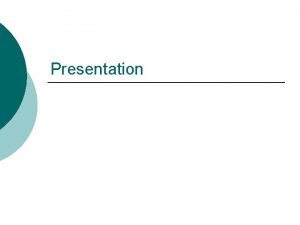Good Morning CONTENTS Introduction Definition Of Health Changing










































- Slides: 42

Good Morning

CONTENTS Introduction Definition Of Health Changing Concepts Of Health Dimensions Of Health Spectrum Of Health Determinants Of Health Conclusion References

CONCEPTS Fundamentals / Principles HEALTH – Sound bodily condition / Soundness / condition of wholesomeness / wellbeing. Source – Webster’s Dictionary

DEFINITION Webster defines health as the condition of being sound in body, mind or spirit especially freedom from physical disease or pain WHO (1948) defines health as a state of complete physical, mental and social well being and not merely an absence of disease or infirmity.

CHANGING CONCEPTS OF HEALTH I. BIOMEDICAL CONCEPT Health has been viewed as an ‘absence of disease’ and if one was free from disease, then the person was considered healthy. This is known as Biomedical concept. This concept was however found inadequate to solve some of major health problems like malnutrition, chronic diseases, accidents etc.

II. ECOLOGICAL CONCEPT The Ecologist put forward a hypothesis, which viewed health as a dynamic equilibrium, between man and his environment, and disease a maladjustment of human organism to environment

III. PHYCHOSOCIAL CONCEPT Health is influenced by social, psychological, cultural, economic and political factors. These factors need to be considered while defining and measuring health

IV. HOLISTIC CONCEPT This concept implies that all sectors of society have an effect on health in particular agriculture, food, industry, education and other sector. This view corresponds to view held by ancients that health implies a sound mind, in a sound body, in a sound family and in a sound environment.

DIMENSIONS OF HEALTH • • • Physical Dimension Mental Dimension Social Dimension Spiritual Dimension Emotional Dimension Vocational Dimension

The physical dimension of health: Perfect functioning of body Biological state in which every cell & every organ is functioning at optimum capacity and in perfect harmony with rest of the body.

Mental dimension: It’s the ability to respond to many varied experiences of life with flexibility and a sense of purpose.

Social dimension: Harmony and integration with in the individual, between each individual and other members of society and between individuals and the world in which they live.

Spiritual dimension: That part of the individual which reaches out and strives for meaning and purpose of life. Includes integrity, principles on ethics, purpose in life, commitment to some higher being.

Emotional dimension: Mental health can be seen as knowing or cognition while emotional health relates to feeling.

Vocational dimension: The importance of this dimension is exposed when individuals suddenly lose their jobs or faces with mandatory retirement.

SPECTRUM OF HEALTH DISEASE Positive Health Better Health Freedom from Sickness Unrecognized Sickness Mild Sickness Severe Sickness Death

DETERMINANTS OF HEALTH Biological Behavioral & Socio-cultural Environmental Socio-economic Health system Aging of the population Science & Technology Information & Communication Gender Equity & Social justice Human rights

BOLOGICAL (1) Human rights EQUITY AND SOCIAL JUSTICE COMMUNITIES FAMILIES GENDER HEALTH SOCIETIES INDIVIDUALS INFORMATION &COMMUNICATION SCIENCE & TECHNOLOGY AGING POPULATION SOCIO CULTURAL HABITS

Biological determinants The physical and mental traits of every human being are to some extent determined by the nature of his genes at the moment of conception. The basic biology and organic make-up of the human body are a fundamental determinant of health.

Genetic endowment provides an inherited predisposition to a wide range of individual responses that affect health status. Although socio-economic and environmental factors are important determinants of overall health, in some circumstances genetic endowment appears to predispose certain individuals to particular diseases or health problems

Socioeconomic determinants Social and economic determinants of health refer to wide range of factors that include occupational status, work conditions and security, educational attainment, housing environment and tenure. It is likely that each factors acts differently on health at each stage of life. cumulatively these factors play a major part in determining the social capital available to both individuals and communities.

Health status improves at each step up the income and social hierarchy. High income determines living conditions such as safe housing and ability to buy sufficient good food. The healthiest populations are those in societies which are prosperous and have an equitable distribution of wealth. Economic status: The percapita GNP is the most widely accepted measure of general economic performance.

Economic status determines the purchasing power, standard of living, quality of life, family size and pattern of disease The economic consequences of unemployment and retirement place many citizens in position of financial vulnerability. Education : The second major factor influencing health status is education(especially female education). the world map of literacy closely coincides with map of poverty, malnutrition, ill health.

Occupation: The very state of being employed in productive work promotes health. unemployed usually show higher incidence of ill health and death. Political system: health is also related to country’s political system. often the main obstacles to implementation of health technologies are not technical, but rather political. Decisions concerning resource allocation, manpower policy, choice of technology and the degree to which health services are made available and accessible to different segments of society are the examples of the manner in which political system can shape the community

Behavioural and socio-cultural determinants Behaviors such as smoking, physical exercise, activity in everyday life, alcohol consumption, diet, self care practices, social contacts, and work style are important factors to population health status and variations in ill health with age. Life style usually reflects the whole range of social values, attitudes and activities. Health requires the promotion of healthy lifestyle. In last 20 years considerable evidence has accumulated which indicates association between health and lifestyle of individuals.

Some persons or groups may face additional health risks due to a socio-economic environment, which is largely determined by dominant cultural values that contribute to the perpetuation of conditions such as marginalization, stigmatization, loss or devaluation of language and culture and lack of access to culturally appropriate health care and services

Environmental determinants It was Hippocrates who related disease to environment. eg (climate, water, air etc) centuries later petenkoffer in Germany revived the concept of diseaseenvironment association. Environment is classified as internal and external. Internal environment pertains to each and every component part, every cell, tissue, organ and their harmonious functioning within the system. External environment is external to individual human host. It can be divided into physical, biological, psychological component

The physical environment is an important determinant of health. At certain levels of exposure, contaminants in our air, water, food and soil can cause a variety of adverse health effects, including cancer, birth defects, respiratory illness and gastrointestinal ailments. In the built environment, factors related to housing, indoor air quality, and the design of communities and transportation systems can significantly influence our physical and psychological well-being.

Personal health services and coping skills Personal Health Practices and Coping Skills refer to those actions by which individuals can prevent diseases and promote self-care, cope with challenges, and develop self-reliance, solve problems and make choices that enhance health Definitions of lifestyle include not only individual choices, but also the influence of social, economic, and environmental factors on the decisions people make about their health.

There is a growing recognition that personal life "choices" are greatly influenced by the socioeconomic environments in which people live, learn, work and play. However, there is a growing recognition that personal life "choices" are greatly influenced by the socioeconomic environments in which people live, learn, work and play.

Health services The term health and family welfare services cover a wide spectrum of personal and community services for treatment of disease, prevention of illness and promotion of health. The purpose of health services is to improve the health status of population. To be effective health services must reach the social periphery, equitably distributed, accessible at the cost so that the country and community can afford and socially acceptable

Education and literacy Health status improves with level of education. Education is closely tied to socioeconomic status, and effective education for children and lifelong learning for adults are key contributors to health and prosperity for individuals, and for the country.

Education contributes to health and prosperity by equipping people with knowledge and skills for problem solving, and helps provide a sense of control and mastery over life circumstances. It increases opportunities for job and income security, and job satisfaction. And it improves people's ability to access and understand information to help keep them healthy

Employment and working conditions Unemployment, underemployment, stressful or unsafe work are associated with poorer health. People who have more control over their work circumstances and fewer stress related demands of the job are healthier and often live longer than those in more stressful or riskier work and activities

Healthy child development New evidence on the effects of early experiences on brain development, school readiness and health in later life has sparked a growing consensus about early child development as a powerful determinant of health in its own right. At the same time, we have been learning more about how all of the other determinants of health affect the physical, social, mental, emotional and spiritual development of children and youth.

Gender refers to the array of societydetermined roles, personality traits, attitudes, behaviors, values, relative power and influence that society ascribes to the two sexes on a differential basis. "Gendered" norms influence the health system's practices and priorities. Many health issues are a function of genderbased social status or roles.

Several reasons have been suggested for these gender differences, prominent among these are behavioral factors such as smoking, alcohol, and exposure to occupational hazards. Conversely women have higher prevalence of chronic conditions and disabilities, particularly in old age.

Political determinants Political decisions shape the social and economic environments and health systems that have important effects on the health of populations Policies involving the organization and delivery of health services, national social security and insurance programmes. The collaboration of health advocacy groups in lobbying policy makers and creating general awareness is key element in promoting the health needs of special communities

Conclusion This has illustrated the need for modern public health teaching, research, and practice to be grounded in both local and global perspectives on the determinants of health and disease in human population the challenges facing public health are great and comprehensive approach to health determinants will be necessary to achieve the full potential of all citizens of the world

CONCULUSION Concepts of health have evolved over the years after series of trails and errors. There is a bound to be changes in the future and one can have an opportunity to reject the existing and take advantage of new knowledge and skills. Whatever the new technological developments one saying is sure to stay HEALTH IS WEALTH

REFERENCES W. H. O. concepts of health, behavior research , 1986. Park K. Textbook of preventive and social medicine, XVIII edn.

THANK YOU
 Buenas tardes good afternoon
Buenas tardes good afternoon Good afternoon class
Good afternoon class Good morning teacher good morning teacher
Good morning teacher good morning teacher Good morning class i know that you are all excited
Good morning class i know that you are all excited Good morning i am
Good morning i am Good morning hi
Good morning hi Hello good afternoon teacher
Hello good afternoon teacher Greetings and responses
Greetings and responses Lady and gentlemen welcome on board
Lady and gentlemen welcome on board Good charlotte good morning revival
Good charlotte good morning revival Good morning good lookin
Good morning good lookin Morning students
Morning students Gentlemen good night ladies good morning
Gentlemen good night ladies good morning Good morning students how are you
Good morning students how are you Good morning students
Good morning students Assalamualaikum & good morning
Assalamualaikum & good morning Morning sentence for class 5
Morning sentence for class 5 Zoroastrianism good thoughts good words good deeds
Zoroastrianism good thoughts good words good deeds If you are
If you are What is the definition of health education
What is the definition of health education Contents introduction
Contents introduction No one loves me
No one loves me Brother john lyrics
Brother john lyrics Good morning to you song
Good morning to you song Good morning in indirect speech
Good morning in indirect speech Receptionist hotel duta good morning can i help you
Receptionist hotel duta good morning can i help you Good morning and welcome back
Good morning and welcome back Good morning 1 june
Good morning 1 june Good morning lady and gentleman
Good morning lady and gentleman Good evening conversation
Good evening conversation Good evening hope you are doing well
Good evening hope you are doing well Good morning welcome june
Good morning welcome june 2 may good morning images
2 may good morning images Good morning to one and all
Good morning to one and all Teacher good morning students
Teacher good morning students Good morning flashcards
Good morning flashcards Good morning please have a seat
Good morning please have a seat Good morning please have a seat
Good morning please have a seat Thank you good morning
Thank you good morning Mary seacole parents
Mary seacole parents Science good morning
Science good morning Dear boys and girls
Dear boys and girls Good morning class
Good morning class

































































